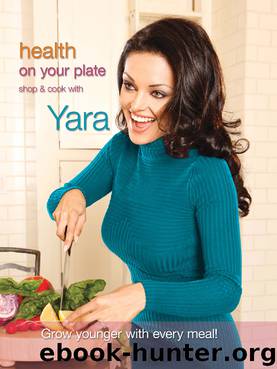Health On Your Plate by Yara Shoemaker

Author:Yara Shoemaker
Language: eng
Format: epub
Tags: Health On Your Plate: Shop & Cook with Yara
ISBN: 9780985864002
Publisher: Yara's Way Llc
Published: 2013-01-23T16:00:00+00:00
A Big, Fat Dilemma
Cow’s milk is a source of calcium, linoleic acid, iodine, magnesium, phosphorus, protein, selenium, vitamins A, B, C, D, E and zinc. It is also high in milk fat. But before you go ordering a “skinny” latte or grabbing a gallon of skim milk, you should know that the body uses fat for more than just love handles.
Many of the nutrients in the list above are fat-soluble, meaning they are absorbed through the digestive tract with the help of dietary fats like milk fat. Taking the natural fat out of milk throws its entire nutritional profile out of sync. In fact, all whole foods contain cofactors – interdependent elements of nutrition that won’t help our bodies unless in the company of all their natural allies. For this reason, many dietitians recommend that anyone who needs to supplement with vitamins do so with the help of tablets made exclusively from plant sources. New Chapter brand supplements are widely available in natural groceries. Even more potent are the LifeGive brand supplements easily ordered online from the Hippocrates Health Institute (bonus: the capsules are made of vegetable cellulose instead of wax).
Here’s the skinny on fat in milk products:
Skim milk is fat-free but also has lower bioavailability of nutrients due to the lack of natural milk fat as a cofactor for absorption.
Low-fat milk has most of the natural fat removed. About 1 percent remains.
Reduced-fat milk is slightly lower in fat than natural milk, about 2 percent.
Whole milk is homogenized (process of skimming fat away from milk, decreasing the size of milk fat molecules and reintroducing them into the milk) to make a uniform fat content of 3.25 percent. True whole milk, as taken from the cow, varies between 3.6 percent and 5.2 percent fat.
Half-and-half is a mixture of equal parts milk and cream. It runs between 10.5 percent and 18 percent fat.
Whipping cream is largely milk fat, making it thicker and creamier. The fat content of light cream is about 30 percent while heavy cream contains 36 percent or more.
Buttermilk is whole, reduced-fat or low-fat milk thickened slightly with bacteria cultures to achieve a smooth consistency and tart flavor. It may be labeled “cultured buttermilk” and is often pasteurized.
Acidophilus milk is typically low-fat or skim milk with added cultures, similar to yogurt, to benefit the digestive tract. 104
Download
This site does not store any files on its server. We only index and link to content provided by other sites. Please contact the content providers to delete copyright contents if any and email us, we'll remove relevant links or contents immediately.
The Bone Broth Miracle: How an Ancient Remedy Can Improve Health, Fight Aging, and Boost Beauty by Ariane Resnick(16452)
How to Be a Bawse: A Guide to Conquering Life by Lilly Singh(7162)
The Fat Loss Plan by Joe Wicks(4629)
The Ultimate Bodybuilding Cookbook by Kendall Lou Schmidt(3713)
A Jewish Baker's Pastry Secrets: Recipes from a New York Baking Legend for Strudel, Stollen, Danishes, Puff Pastry, and More by George Greenstein(3458)
The French Women Don't Get Fat Cookbook by Mireille Guiliano(3423)
Better Homes and Gardens New Cookbook by Better Homes & Gardens(3377)
Super Food Family Classics by Jamie Oliver(3252)
Dinner in an Instant by Melissa Clark(3004)
Bread Revolution by Peter Reinhart(2995)
Tom Kerridge's Dopamine Diet: My low-carb, stay-happy way to lose weight by Kerridge Tom(2957)
Body Love by Kelly LeVeque(2909)
Ottolenghi - The Cookbook by Yotam Ottolenghi(2744)
Flavor Flours by Alice Medrich(2651)
The Fat Chance Cookbook by Robert H. Lustig(2645)
Tone Your Tummy Type by Denise Austin(2640)
Oh She Glows Every Day by Angela Liddon(2635)
LL Cool J's Platinum 360 Diet and Lifestyle by LL Cool J(2588)
The Kitchen Counter Cooking School by Kathleen Flinn(2401)
